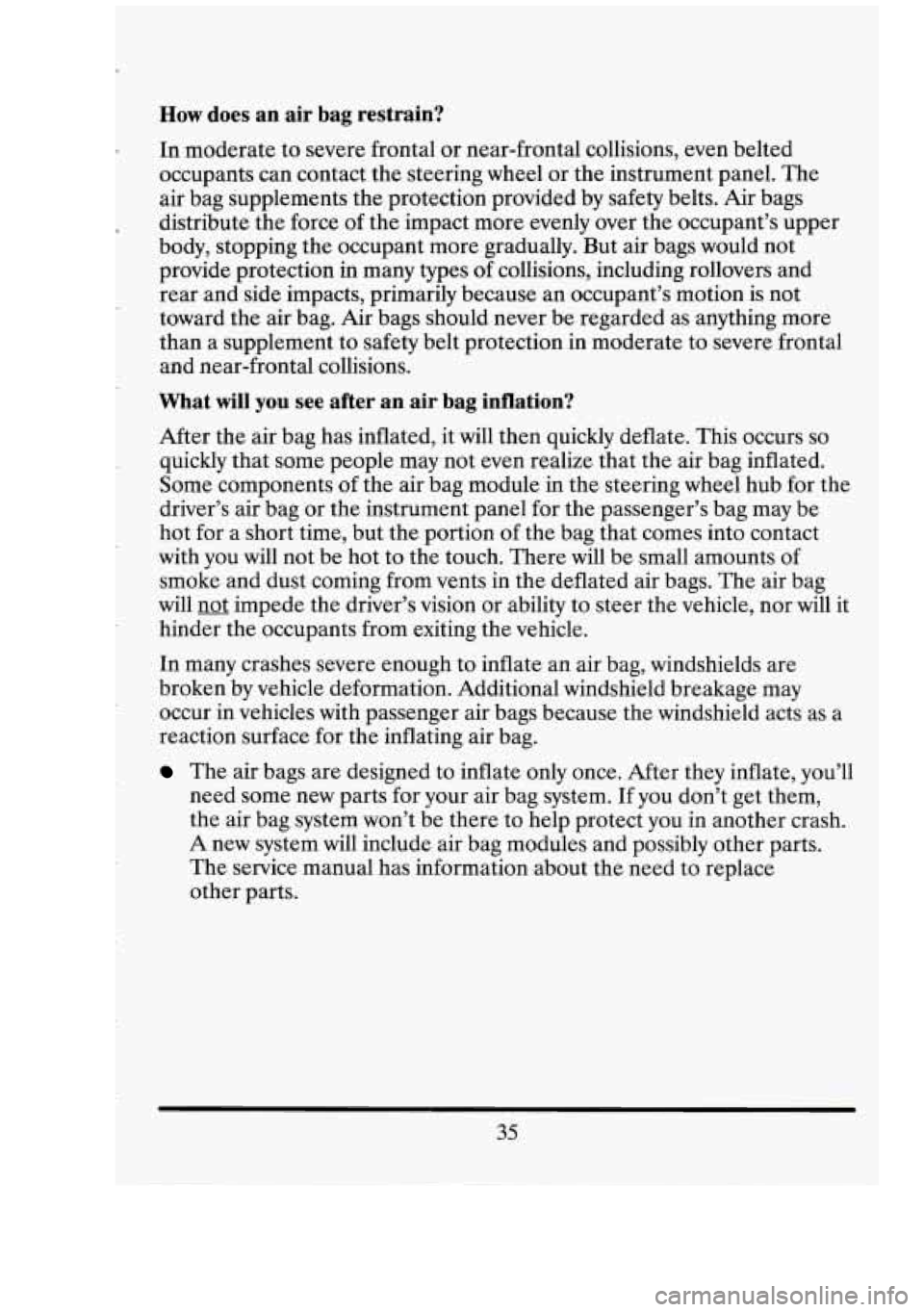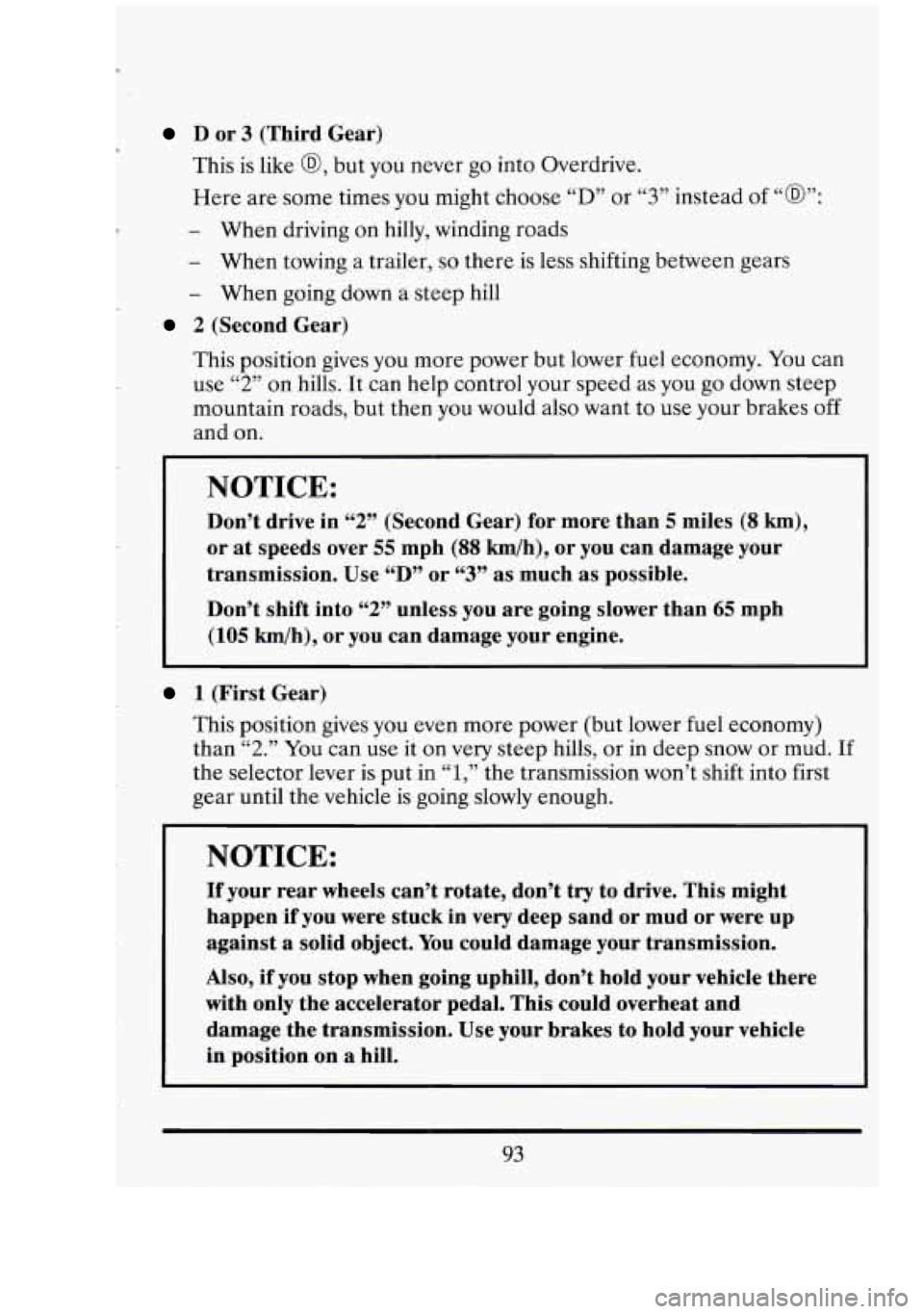Page 48 of 398

How does an air bag restrain?
In moderate to severe frontal or near-frontal collisions, even belted
occupants can contact the steering wheel or the instrument panel. The
air bag supplements the protection provided by safety belts. Air bags
distribute the force of the impact more evenly over the occupant’s upper
body, stopping the occupant more gradually. But air bags would not
provide protection in many types
of collisions, including rollovers and
rear and side impacts, primarily because an occupant’s motion
is not
toward the air bag. Air bags should never be regarded as anything more
than a supplement to safety belt protection in moderate to severe frontal
and near-frontal collisions.
What will you see after an air bag inflation?
After the air bag has inflated, it will then quickly deflate. This occurs so
quickly that some people may not even realize that the air bag inflated.
Some components of the air bag module in the steering wheel hub for the
driver’s air bag or the instrument panel for the passenger’s bag may be
hot for a short time, but the portion of the bag that comes into contact
with you will not be hot to the touch. There will be small amounts of
smoke and dust coming from vents in the deflated air bags. The air bag
will
not impede the driver’s vision or ability to steer the vehicle, nor will it
hinder the occupants from exiting the vehicle.
In many crashes severe enough to inflate an air bag, windshields are
broken by vehicle deformation. Additional windshield breakage may
occur in vehicles with passenger air bags because the windshield acts as a
reaction surface for the inflating air bag.
The air bags are designed to inflate only once. After they inflate, you’ll
need some new parts for your air bag system. If you don’t get them,
the air bag system won’t be there to help protect you in another crash.
A new system will include air bag modules and possibly other parts.
The service manual has information about the need to replace
other parts.
35
Page 76 of 398
Q: What if a child is wearing a lap-shoulder belt, but the child is so
small that the shoulder belt is very close to the child’s face or neck?
A: Move the child toward the center of the vehicle, but be sure that the
shoulder belt still is
on the child’s shoulder, so that in a crash the
child’s upper body would have the restraint that belts provide.
If the
child is
so small that the shoulder belt is still very close to the child’s
face or neck, you might want to place the child in the center seat
position, the one that has only a lap belt.
63
Page 99 of 398

I
The other positions let you perform these functions:
ACC: Accessory lets you use things like the radio and the windshield
wipers when the engine is
off. To get into “ACC”, push in the key and turn
it toward
you. Yoursteeringwheel will remain locked, just as it was
before you inserted the key.
OFF: This position lets you turn off the engine but still turn the steering
wheel. It doesn’t lock the steering wheel like “Lock.” Use “Off”
if you
must have your car in motion while the engine is
off (for example, if your
car is being pushed).
RUN This is the position for driving.
START This starts your engine.
NOTICE:
If your key seems stuck in “Lock” and you can’t turn it, be sure
it
is all the way in. If it is, then turn the steering wheel left and
right while. you turn the key hard. But turn the key only with
your hand. Using
a tool to force it could break the key or the
ignition switch.
If none of this works, then your vehicle needs
service.
STARTING YOUR ENGINE
Move your shift lever to “P” (Park) or “N” (Neutral). Your,,engine won’t
start in
any other position -- that’s a safety feature. To restart when you’re
already moving, use “N” (Neutral) only.
NOTICE:
Don’t try to shift to “P” (Park).. if your Cadillae is moving. If you
do, you could .damage the transmission. Shift to “P” (Park) only
when your vehicle
is stopped. ”. .
1
W I
D
I
I
-
Page 101 of 398
NOTICE:
Your engine is designed to work with the electronics in your
vehicle.
If you add electrical parts or accessories, you could
change the
way the fuel injection system operates. Before
adding electrical equipment, check with your dealer.
If you
don’t, your engine might not perform properly.
If you ever have to have your vehicle towed, see the part
of this
manual that tells how to do it without damaging your vehicle.
See “Towing Your Vehicle’’ in the Index.
I
L
DmNG THROUGH DEEP STMDING
WATER
NOTICE:
If you drive too quickly through deep puddles or standing water,
water can come in through your engine’s
air intake and badly
damage your engine.
If you can’t avoid deep puddles or standing
water, drive through them very slowly.
Page 105 of 398
I
A
N (Neutral)
In this position, your engine doesn’t connect with the wheels. To
restart when you’re already moving, use “N” (Neutral) only. Also, use
“N” when your vehicle is being towed.
NOTICE:
Damage to your transmission caused by shifting out of “P”
(Park)
or “N” (Neutral) with the engine racing isn’t covered by
your warranty.
0 @ (Automatic Overdrive)
This position is for normal driving. If you need more power for
passing, and you’re:
- Going less than about 35 mph (60 km/h), push your accelerator
- Going about 35 mph (60 h/h) or more, push the accelerator all
pedal about
halfway down
the way down.
You’ll shift down to the next gear and have more power.
7’ P
I
1
92
Page 106 of 398

D or 3 (Third Gear)
This is like
@, but you never go into Overdrive.
Here are some times you might choose
“D” or “3” instead of “@”:
- When driving on hilly, winding roads
- When towing a trailer, so there is less shifting between gears
- When going down a steep hill
2 (Second Gear)
This position gives you more power but lower fuel economy.
You can
use
2 on hills. It can help control your speed as you go down steep
mountain roads, but then you would also want to use your brakes off
and on. (6 77
NOTICE:
Don’t drive in “2” (Second Gear) for more than 5 miles (8 km),
or at speeds over 55 mph (88 km/h), or you can damage your
transmission. Use
“D” or “3” as much as possible.
Don’t shift into
“2” unless you are going slower than 65 mph
(105 km/h), or you can damage your engine.
1 (First Gear)
This position gives you even more power (but lower fuel economy)
than
“2.” You can use it on very steep hills, or in deep snow or mud. If
the selector lever is put in “1,” the transmission won’t shift into first
gear until the vehicle is going slowly enough.
NOTICE:
If your rear wheels can’t rotate, don’t try to drive. This might
happen
if you were stuck in very deep sand or mud or were up
against
a solid object. You could damage your transmission.
Also, if you stop when going uphill, don’t hold your vehicle there
with only the accelerator pedal. This could overheat and
damage the transmission. Use your brakes to hold your vehicle
in position on
a hill.
93
Page 107 of 398
TMLER TOWING PACMGE (OPTION)
If your Fleetwood is equipped with either V92 or V4P package, you can
increase your vehicle's trailer towing capability to
5,000 pounds (2270 kg)
or 7000 lbs. (3178 kg). To determine which package you have, see the
Service Parts Label located on the underside
of the trunk lid. These
packages include a trailering harness located
in the trunk, heavy-duty
engine and transmission cooling.
Also included are heavy-duty front and
rear springs, 2.93:l rear axle ratio and Eagle
GA P235/70R15 tires.
3
a,
I
I
P-NG BRAKE
The parking brake uses the brakes on the rear wheels.
To set the parking brake:
Hold the regular brake pedal down with your right foot. Push down the
parking brake pedal with your left foot.
If the ignition is on, the brake
system warning light will come
on.
I
94
Page 109 of 398
If you are on a hill: See “Parking on Hills” in the Index. That section
shows how to turn your front wheels.
If you are towing a trailer and are parking on any hill: See “Towing a
Trailer” in the Index. That section shows what to do first to keep the
trailer from moving.
SHIFTING INTO 44P” (PARK)
Steering Column Shift Lever
1. Hold the brake pedal down with your right foot.
E
1
n !fl
I
96
..